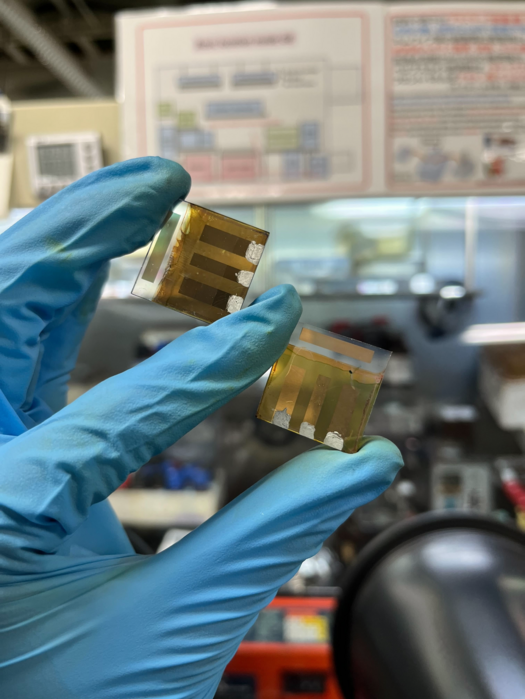At the Institute for Open and Transdisciplinary Research Initiatives at Osaka University, scientists have found a new feature of solar cells that has been created from antimony sulfiodide: sulfide composite they referred to as the wavelength-dependent photovoltaic effect (WDPE).
 Photograph of SbSI and SbSI:Sb2S3 photovoltaic devices. Image Credit: Ryosuke Nishikubo.
Photograph of SbSI and SbSI:Sb2S3 photovoltaic devices. Image Credit: Ryosuke Nishikubo.
The research group has found that altering the color of incident light from visible to ultraviolet induced a reversible change in the output voltage while exiting the current generated unaltered. This work could result in new functional light-sensing and imaging devices.
Photovoltaic (PV) devices — like photodiodes and solar cells — that convert light energy into electronic power are essential as renewable energy sources or as light or image sensors.
New advances happened in thin-film PV devices have gained huge attraction as a result of their affordable process, lightweight and flexibility. However, although various PV devices have been reported so far, reversible and fast wavelength-dependent responses have not been previously noted.
To differentiate between irradiation colors with the help of a single photodiode, it is essential to use a liquid crystal filter that has the potential to electronically switch the absorption color range.
But such filters are huge; being able to execute color detection without needing such filters would be beneficial for reducing the size of photovoltaic devices.
Currently, a research group at Osaka University has constructed new photovoltaic devices created from antimony sulfiodide: sulfide composite and discovered a novel effect.
The voltage produced could be altered by shifting the light color, in which ultraviolet decreased the output voltage. This implies that a reversible change happening in the current versus voltage curves could be achieved just by shining various colors of light on the device.
Such a dramatic shift in voltage is not observed in silicon, perovskites, or organic solar cells.
Ryosuke Nishikubo, Study First Author, Osaka University
To gain better insights into the mechanism behind this effect, the researchers further executed transient photovoltage (TPV) and photo-induced charge extraction by linearly rising voltage (photo-CELIV). Such experiments helped verify the considerable and reversible change in charge carrier lifetime that has been induced by ultraviolet irradiation.
The team came to the conclusion that WDPE was caused by metastable “trap” states at the heterojunction interface, produced by high energy charges. Such interfacial energy tends to trap considerably decreased output voltage, consequently, the light of some energies could be differentiated based on the voltage. This change could be improved by the presence of the vapor obtained from a polar solvent.
While our work helps advance basic science by explaining this novel effect, the research also has many potential applications, including as a vapor detector.
Akinori Saeki, Study Senior Author, Osaka University
The newly found phenomenon could be employed in light-sensing that is utilized in everything from mobile phones to cars, to security or horticultural systems.
It can also be a part of imaging applications in medical and other scientific pursuits, like microphotography and space satellites. It could also be of use as a renewable energy source due to its low production cost and low toxicity.
Journal Reference:
Nishikubo, R., et al. (2022) Unprecedented Wavelength Dependence of an Antimony Chalcohalide Photovoltaic Device. Advanced Functional Materials. doi.org/10.1002/adfm.202201577.